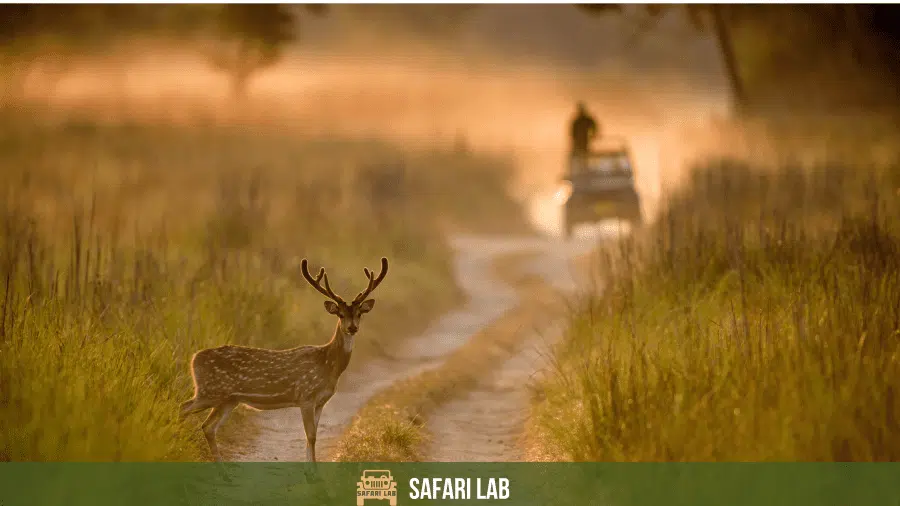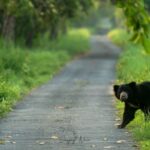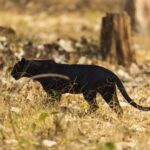Imagine you’re on a safari in India’s dry deciduous forests, the landscape parched and brown under the harsh sun. And suddenly, you see it—a burst of fiery orange-red in the distance, almost as if the land itself is burning. That’s no wildfire though; that’s the Flame of the Forest—or as locals call it, Palash (Butea monosperma).This tree is more than just its striking beauty. It’s a keystone species in its ecosystem, an Ayurvedic healer, a cultural symbol, and a haven for wildlife. This beauty bursts into color between February and April, just when the rest of the forest is turning dry and brown. It’s truly a survivor’s tree. The Indian Roller, with its brilliant blue wings, is often spotted perched on its branches, surveying the ground for prey.For insects, including bees, the Palash is a lifeline during the dry season, helping with cross-pollination and supporting biodiversity. Its role doesn’t stop there—the tree’s fallen flowers and leaves enrich the soil, promoting soil health, and allowing other plant life to thrive in its wake.
The Indian Roller, with its brilliant blue wings, is often spotted perched on its branches, surveying the ground for prey.For insects, including bees, the Palash is a lifeline during the dry season, helping with cross-pollination and supporting biodiversity. Its role doesn’t stop there—the tree’s fallen flowers and leaves enrich the soil, promoting soil health, and allowing other plant life to thrive in its wake.
Jump To
ToggleA Botanist’s Dream: Deep Dive into the Tree’s Features
The Flame of the Forest belongs to the Fabaceae family and is a deciduous tree, which means it sheds its leaves seasonally. Standing about 12–15 meters tall, its crooked branches twist and turn, giving the tree a rugged, almost ancient look. The bark is rough, dark grayish-brown, and full of medicinal properties (we’ll get to that). Its trifoliate leaves—three large leaflets—are leathery and tough, often used as natural plates in rural India.The Flowers: Now, what really makes this tree famous are its flame-like flowers. Blooming in late winter to early spring, from February to April, the flowers are vivid orange-red and clustered in dense bunches at the end of branches. These aren’t just decorative; they’re actually perfectly adapted to draw in pollinators like birds, bees, and insects when other plants are sparse. Each flower is shaped like a claw, earning it the name “Tiger’s Claw” in some regions.A Key Player in the Ecosystem
From an ecological perspective, the Palash tree is a crucial part of India’s dry deciduous forests. Why? Because during the dry season, when most other trees are dormant or leafless, the Palash is in full bloom, offering nectar and food to various wildlife species.Birds, bees, and butterflies all flock to these bright flowers. The tree plays host to a variety of nectar-feeding birds like Purple Sunbirds, Oriental White-eyes, and even Red-vented Bulbuls. These birds not only feed on its nectar but also help pollinate the tree as they flit between branches.
birds on flame of the forest
Cultural Significance of Flame of the forest: From Festivals to Folklore
The Palash tree isn’t just a star in the animal kingdom; it has been revered in Indian culture for centuries. Its flowers are traditionally used to make natural dyes for Holi, the festival of colors. You might have heard that ancient texts and folklore often reference this tree. In fact, Rabindranath Tagore himself was deeply inspired by the Palash, writing about its flowers in his poems.Even the tree’s leaves have cultural significance. Ever heard the phrase “Dhak ke teen paat” in Hindi? It literally means “the three leaves of the Dhak tree,” referring to the trifoliate leaf arrangement of the Palash, but it’s used metaphorically to imply something predictable. These leaves are also used in rituals, eco-friendly plates, and even as fodder for livestock in many parts of rural IndiaThe Medicinal Side: Nature’s Healer
In Ayurveda, the Flame of the Forest is a bit of a multi-tasker. Almost every part of the tree—the flowers, bark, seeds, and gum—has a medicinal use.- The bark is used to treat skin disorders and wounds.
- The seeds are ground into a paste for treating skin ailments like eczema and ringworm
- The gum, known as Bengal Kino, is an astringent and is commonly used in traditional remedies for diarrhea and dysentery
How to Spot the Palash Tree on Safari
If you’re out on a safari and want to spot this beauty, here’s how you can identify it:- Flowers first: Look for the fiery orange-red flowers that cover the tree before any leaves appear. These blooms make the tree stand out, especially during the dry season when most trees are bare.
- Rugged trunk: The bark is rough, cracked, and dark brown. It’s not smooth or uniform like other trees, adding to its rustic charm.
- Trifoliate leaves: Once the flowering season passes, the Palash sprouts its characteristic three-part leaves, which are thick and leathery.
Birdlife to Watch Out For
Apart from the more common nectar feeders, there are a few surprises you might spot:- Yellow-footed Green Pigeon: You might catch these birds perched on the Palash, enjoying the cool shade.
- Coppersmith Barbet: Known for its metallic call, this bird often pecks at the tree’s trunk, searching for insects.
- Black Drongo: Often seen perched on its bare branches, using the tree as a vantage point to spot flying insects.

























